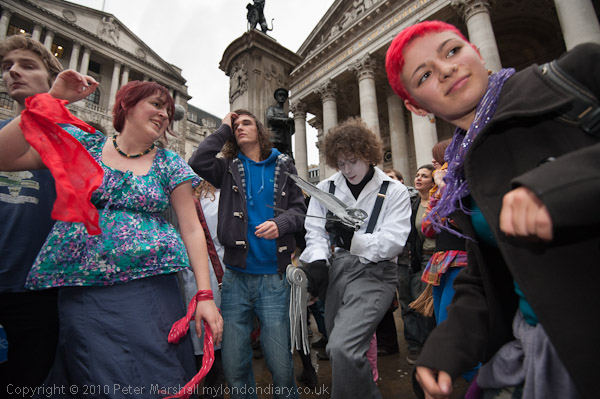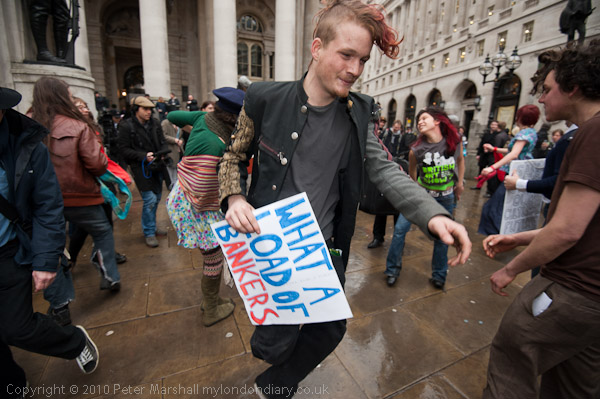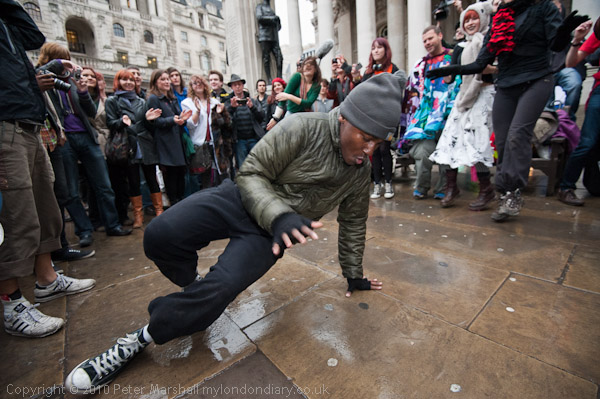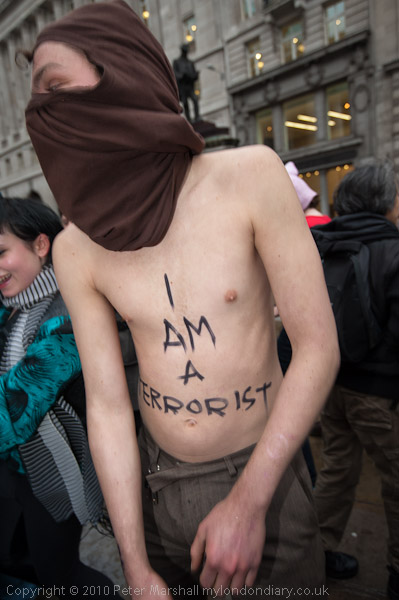
Last Friday I was at Bank at lunchtime, along with perhaps 80 demonstrators and what seemed like at least as many photographers and videographers. It perhaps attracted so many cameras because it was really the first well-publicised event against the cuts and the fees rise since students came back after the Christmas break, or perhaps it was because it was a demonstration particularly by those involved in the arts and so would have been well publicised in all the art colleges. Of course everyone has a right to come and take photos, but it does make working a little more difficult, both as they get in your way and I try to keep – as much as possible – out of theirs.
Despite the murky weather with the occasional drop of rain it was a lively event. I started off working at ISO 1000 without flash, and using the Nikon 16-35mm there didn’t seem much reason to stop down below its maximum aperture of f4 – it’s sharp enough wide open and at 16mm you have pretty decent depth of field, while at 35mm you can certainly make fairly close subjects stand out a little against a slightly blurred background.
Once the dancing started I began to add some flash, as although I was getting a shutter speed of around 1/200 there can still be a little blur with close subjects, and the flash also brings the main subject out just a little.

ISO 1000 1/160 f4, balanced flash fill, 16mm
Once the break dancing started, I decided I needed a faster shutter speed and increased the ISO to 1600:

ISO 1600 1/320 f4, balanced flash fill, 16mm

ISO 1600 1/200 f4, balanced flash fill, 23mm
Without the flash, this ‘terrorist’s’ head would have been too blurred as he was dancing pretty energetically – you can see the slight double exposure effect there, while his torso was moving less rapidly and has remained sharp. I think the blur adds to the image, but it needs the sharpness of the flash exposure too.
The shutter speed changed a little frame to frame, as I was working using aperture priority auto-exposure. It might have been better to switch to manual exposure, as the lighting was pretty constant over the area, and the shutter speed changes probably just reflect the amount of sky in the image. But I prefer to work on auto when covering events, as I seldom have time to think about exposures, and if for some reason the light does change can get images that are too far over or under-exposed. All of the pictures I took were more or less correctly exposed – well within the limits of simple adjusted in processing the RAW files. If I was taking pictures of landscape or some other subjects where I would always have time to think I’d stick to manual and work to get the exposures spot on (probably using spot metering too) every time. For photographing events I normally stick to matrix metering.
When using flash, the camera metering system doesn’t seem to compensate for the extra light, so most of these pictures are taken with exposure compensation on both camera and flash at -1/3 or -2/3 stop to avoid burning out the highlights.
Almost all of the time I also use autofocus, and with rapidly moving events like this that usually means the continuous servo autofocus (C) mode that will attempt to track a moving object. The D700 (and other Nikons including the D300) has three autofocus area modes, and I often find myself switching between these while taking pictures. Probably the most useful is the Dynamic Area AF, where you select the focus point (I normally use 51 points) but when things get very hectic I sometimes switch to auto-area and let the camera decide. The danger in using it is that it may focus on close foreground which you would happily leave blurred. But if you use autofocus on a selected area, it is all too easy for that area to be the background when you are working rapidly.
Back in the old days of range-finder cameras with manual focus when I was working on film I would always rely on ‘zone focus’ – setting focus and aperture perhaps so that depth of field covered everything from 5-8 foot. Occasionally I still do so, though it’s less convenient with zoom lenses and no (or inadequate) depth of field scales, as once set, it is faster than the best autofocus!
You can see more pictures from this event – and read more about it – at Dance Against The Deficit Lies on My London Diary.